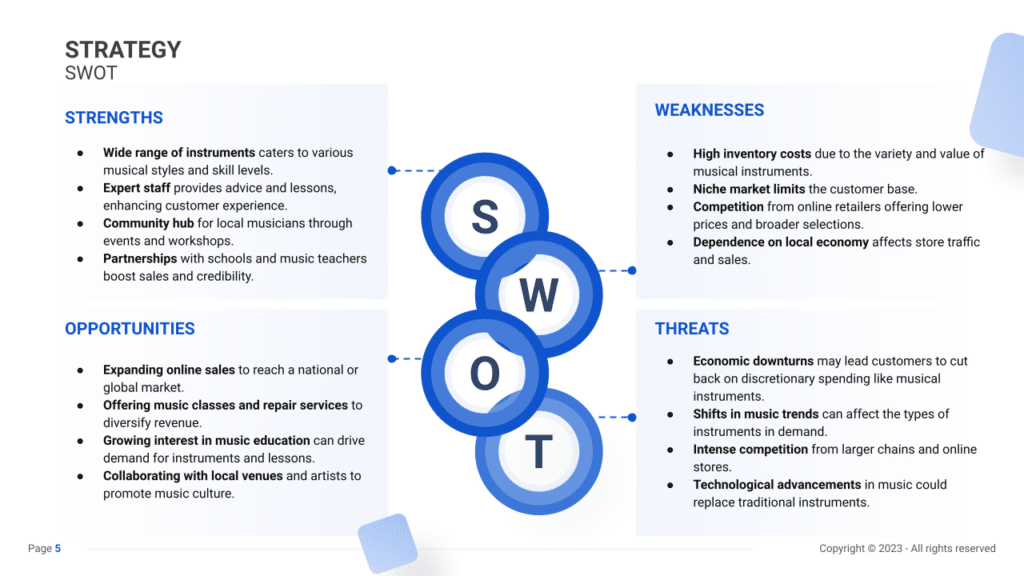SWOT analysis for a Musical Instrument Store (Example)

A SWOT analysis is crucial for developing a business plan for a musical instrument store. This analysis, which stands for Strengths, Weaknesses, Opportunities, and Threats, helps in understanding internal and external factors that can impact your business. Strengths and weaknesses are internal to the business, while opportunities and threats are external.
In this article, we will explore various examples of strengths, weaknesses, opportunities, and threats, aiding musical instrument store owners in incorporating these insights into their business strategies.

Strengths
Highlight the strengths of a musical instrument store to solidify its standing in the market:
- Wide Product Range: Offering an extensive array of musical instruments spanning diverse categories such as guitars, pianos, drums, and accessories provides customers with ample choices.
- Example: Showcase the store’s broad inventory through engaging displays and interactive sections highlighting instrument versatility.
- Expert Staff: Employing knowledgeable and passionate staff members well-versed in various instruments and musical genres can enhance the customer experience.
- Example: Organize in-store workshops or demonstration sessions led by proficient staff to educate customers and foster engagement.
- Repair and Maintenance Services: Providing reliable instrument repair and maintenance services can be a significant competitive advantage.
- Example: Promote the store’s repair services prominently, emphasizing quick turnaround times and quality craftsmanship.
- Online Presence: Maintaining a robust online presence with e-commerce capabilities enables a wider reach and accessibility beyond physical limitations.
- Example: Develop a user-friendly website with detailed product information, online purchasing options, and educational content like tutorial videos or blog posts.
Weaknesses
Address weaknesses to fortify the musical instrument store’s market position:
- High Price Points: Selling high-end instruments might limit customer accessibility due to cost constraints.
- Example: Introduce flexible financing options or rental programs to accommodate customers with varying budgets.
- Limited Brand Diversity: Over-reliance on specific brands or a narrow range of instruments might deter customers from seeking diverse options.
- Example: Forge partnerships with new brands or expand the inventory to encompass a wider spectrum of instrument choices.
- Seasonal Demand: Fluctuations in demand for certain instruments based on seasons or trends can lead to inventory management challenges.
- Example: Offer promotions or package deals during off-peak seasons to stimulate sales and manage inventory turnover effectively.
- Technological Lag: Failure to adopt or showcase modern technological advancements in instruments or online sales platforms might hinder competitiveness.
- Example: Invest in new digital instruments or integrate virtual reality experiences for customers to explore instruments remotely.
Opportunities
Identify and leverage opportunities that can foster growth and innovation for a musical instrument store:
- Educational Partnerships: Collaborating with educational institutions for bulk sales or offering student discounts can establish a steady customer base.
- Example: Establish exclusive partnerships with schools or music academies for instrument procurement, accompanied by promotional offers.
- Evolving Music Trends: Keeping abreast of emerging music trends and stocking instruments aligned with these trends can attract enthusiasts.
- Example: Conduct market research or surveys to understand evolving musical tastes and introduce instruments catering to these preferences.
- Online Learning Platforms: Developing or partnering with online music learning platforms can complement instrument sales.
- Example: Create tie-ins with renowned online music tutorial services to attract aspiring musicians and provide added value.
- Sustainability Initiatives: Responding to the rising demand for eco-friendly instruments or sustainable manufacturing can open a niche market.
- Example: Source or manufacture instruments using sustainable materials and promote eco-consciousness in marketing campaigns.
Threats
Prepare for potential threats to the resilience of a musical instrument store:
- Competitive Online Retailers: Intense competition from online retailers might impact foot traffic and sales at physical stores.
- Example: Emphasize the in-store experience, personalized assistance, and additional services not available online to counteract this threat.
- Economic Downturns: Economic recessions or downturns can lead to reduced consumer spending on non-essential items like musical instruments.
- Example: Implement flexible pricing strategies or finance options to accommodate customers facing financial constraints.
- Counterfeit Products: The influx of counterfeit or low-quality instruments in the market can tarnish the store’s reputation and customer trust.
- Example: Educate customers about identifying genuine instruments and ensure transparent sourcing to mitigate this threat.
- Logistical Challenges: Disruptions in global supply chains or shipping delays can impact inventory availability and timely deliveries.
- Example: Maintain diversified supplier networks and buffer inventory to mitigate potential disruptions.





